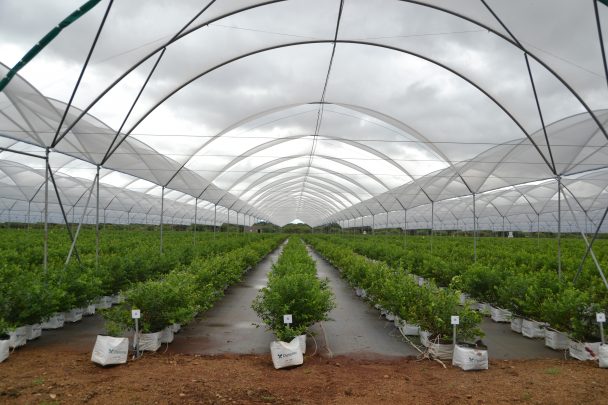In this series we discuss the design of irrigation systems for fertigation. Fertigation means the application of dissolved nutrients through an irrigation system. The total or partial requirement for specific elements can be divided and applied. Single products or combinations of products in a liquid or water-soluble form can be used.
The main purpose of fertigation is the maximum production of good quality crops through the optimal utilisation of water and fertiliser, as well as the manipulation of plant physiology processes to ensure optimal vegetative growth. These production objectives (yield and quality) are determined by the market for which production is intended, and are influenced by the fertigation programme followed. The soil or medium in which cultivation is done, is used as storage or a buffer (the soil’s resistance to drastic chemical changes) from which the plant can freely absorb fertilisers.
A fertigation programme is compiled by considering the fertiliser contribution of the irrigation water and the soil’s nutritional balance. The irrigation water and fertiliser compound, as well as the chemical and physical interactions between the soil or medium, can however seriously influence the ability of the soil or medium to act as a buffer.
Fertigation is more important in cases of sandy, gravelly, or stony soils with a low nutritional retention ability, as well as chemically poor-balanced soils and irrigation water combinations. The use of localised wetting irrigation systems like drip irrigation systems allows less dependence on the soil’s provision and buffer ability.
Irrigation systems
The nutrient requirement of any crop at a specific stage depends on the cultivar, type of crop, phenological growth stage, plant density of the crop, climatic conditions and the expected yield. As mentioned, soils differ regarding their inherent fertility, as well as their ability to act as buffer. It is therefore essential that soil mapping should be done beforehand, so that the differences between soils can be indicated on a chart. The farmer, crop specialist, soil scientist, and a fertiliser specialist must take into consideration the information concerning the water, as well as the nutrient requirements and scheduling for specific crops, and make recommendations to the irrigation designer. The designer and producer must jointly decide on the most suitable fertigation irrigation system, as well as the layout, based on the information gained.
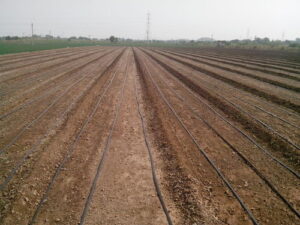
A recent completed drip irrigation system. Indiamart.com
Fertiliser compounds can be applied by any type of irrigation system, namely drip, micro, sprinkler, flood and moving irrigation systems.
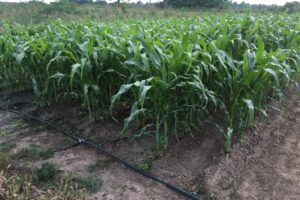
Fertigation is the optimisation of your water and fertiliser resources by applying them together. Photo: hosstools.com
The designer must keep the following aspects in mind when planning and designing an irrigation system for fertigation application:
- Position of irrigation system – The safety of people, tame animals, wildlife and other non-target areas (water sources, adjacent orchards, roads, et cetera).
- Water losses with accompanying losses in fertiliser as a result of run-off are especially a problem with micro and sprinkler systems. Run-off is not only influenced by the irrigation system’s application rate and the soil’s infiltration rate, but also by the slope of the land, ground cover, condition of the crop and the water status of the soil. Measures to prevent excessive run-off must be taken beforehand. Soils with a high clay content, combined with a high rainfall area, or where serious crust-forming occurs, can cause surface run-off with a resulting low application efficiency.
- The Christiansen distribution
uniformity (CU), and the emission uniformity (EU) of the designed systems must comply with the set design norms to ensure uniform application of the fertiliser products. CU is defined as the average depth of irrigation water applied, minus the average absolute deviation from this depth, all divided by the average depth applied. EU is defined as the average discharge of 25% of the sampled emitters with the least discharge, divided by the average discharge of all sampled emitters. It is important that the irrigation system be evaluated in the field to ensure that the system complies with the local design norms before fertigation is applied. The irrigation system must always irrigate at the operating pressure as specified in the design. - The choice of the most suitable injection equipment for the specific producer’s circumstances, considering the required safety measures.
- The flow rate of each block may differ. It is recommended that all information, for example the flow rate and area per block, be considered in determining the injection rate and injection time.
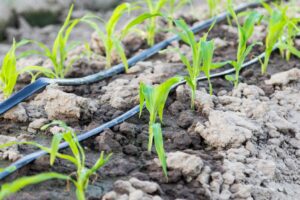
Drip irrigation delivers the right amount of water and fertiliser to the individual plants. Photo: interplast.com
The following maintenance and management measures should be followed by the farmer:
- In conventional fertigation, the irrigation system must be on pressure before fertigation can be started. Sprinkler systems must irrigate for at least 15 minutes before fertigation is applied, to ensure a uniform application.
- A colourant can be sent through the water to determine the time necessary for the fertiliser to reach the last emitter. Available injection time is usually calculated as a third of the application time (Wilson, 1996).
- Special maintenance procedures such as chlorination and pre-treatment of irrigation water may be necessary before fertigation can be applied.
- Effective scheduling of irrigation water is a prerequisite for optimal fertigation. The quantity of water applied through the irrigation system depends upon the water capacity of the soil.
Before fertigation is applied, the depth of application must be determined by considering the application rate of the irrigation system, duration of the irrigation and the soil’s water content at this specific stage. Fertigation must be injected within the limits to prevent deep percolation in sandy soils. - After completion of a conventional fertigation programme, the system must be flushed with clean water to prevent excessive corrosion. The danger exists, however, that, with the flushing process, the fertiliser compound can be washed deeper into the root zone.
- To prevent damage to the plant roots as a result of a high fertiliser concentrate, the fertiliser concentration in the irrigation water should never exceed 5%. Concentrations of 1% to 2% in the irrigation water are usually acceptable.
- Soil water extractors, plant sap analysis and mini laboratories can be used to manage the nutrient balances within the root zone effectively, for example EC, pH, nitrates and nitrites. Graphs must be drawn of the readings taken to notice tendencies in time.
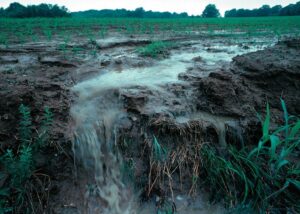
Bad planning of an irrigation system can cause the fertiliser to enter natural water sources, causing water pollution. Photo: Wikipedia.org
Fertigation can have the following benefits or disadvantages:
Benefits
- The accurate and uniform application of fertiliser is possible if the irrigation system is well-designed and if a reliable maintenance schedule is maintained.
- The quantity and concentration of the fertiliser can be adjusted to the plant’s requirements, phenological stages and the climatic conditions. Fertigation is even possible if the soil is very wet, by applying just enough water for fertigation. This type of irrigation is known as a technical irrigation.
- Prevention of leaching of fertiliser products beneath the root zone is possible by correct management that will prevent pollution of the sub-surface water sources.
- Time and labour costs are reduced because the fertiliser products are applied through the irrigation system.
- Application is possible through all types of irrigation systems and during all the growth stages of the crop.
Disadvantages
- Fertigation requires a high standard of management. Personnel must therefore be well-trained.
- Some solutions may be corrosive for certain irrigation equipment.
- Additional equipment and capital outlay may be needed for fertigation.
- Pollution of the water source is a possibility if the correct non-return valves are not installed. Safety measures must be followed accurately, especially where drinking water is involved.
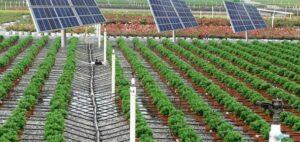
Fertigation is an advanced system, and well-trained personnel are needed to operate it. Photo: theindianiris.com
Published with acknowledgement to the ARC Agricultural Engineering for the use of their fertigation manual. Visit www.arc.agric.za for more information.
References
- ‘Irrigation Systems’ of the Irrigation Design Manual, Chapter 10 (Burger et al 1996).

